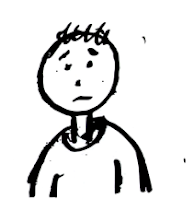I need to delve into a little theory (sorry!) but I think this is my most important post yet:

Pablo Picasso painted a picture called the
Head of a Medical Student in 1907. Famously known for his abstract style, Picasso portrays the medical student with one eye opened and one eye closed. To a large extent, medical school training involves desensitization to the body and trauma. This happens from the very first semester during anatomy as one begins the process of dissecting a human into a series of body parts. The process of desensitization continues as one watches a trauma response to a car accident victim, a neonate who is not breathing, a psychiatric patient with hallucinations, and a surgery with unexpected complications. We are taught that desensitization is a good thing, that it is something essential to our ability to practice as physicians. We need to be desensitized, to keep our emotions in check, in order to do our jobs.
But at the same time, we are taught to empathize with our patients. We try to learn their life stories and listen to the very intimate details of their lives. We are taught to pay attention to body language, draping, positioning of chairs, and the way we ask questions in order to make patients more comfortable. We learn to be aware of social disparities in health care, access to insurance, and different cultural beliefs in medicine. Yet, I still feel that there is an "us" versus "them" mentality between doctors and patients. So I need to ask the question, are we doing enough?
I propose that physicians learn to see the world with two eyes open. Why do we actually need to be desensitized? I have yet to be in a surgery or dissection in which I was not aware of the fact that I was cutting into a human body. I can remember several experiences in which I was fully aware of the emotional and moral consequences of a procedure. Basically, it is the understanding of "what is at stake" for the patient.
For example, when I was on my surgery rotation, I had a patient with pancreatic cancer who was brought to the OR to attempt a risky procedure to remove the tumor. Due to the extensive nature of the cancer, which was unexpected, we had to stop the surgery and close up her abdomen. I remember physically feeling the hard tumor on her pancreas with my own gloved hands. I was aware of more than just the fact that I wasn't going to see a Whipple procedure. In actuality, I was consumed with the concept that as soon as we closed her abdomen, we were going to have to deliver some devastating news. It was like looking death straight in the face and feeling utterly unable to do anything to prevent it. I even remember feeling so sad about this that I was near tears. As I continue to follow this patient post-op, I remember being a little wary of what I was going to say. What could I, as a medical student, offer to this patient?
Rather than shy away from her room (as it is so easy to do while on the wards), I tried to bring myself into her room at least once every afternoon to sit down with her and have a conversation. I did not talk about disease or treatment, but I just listened to her voice her concerns and tried to answer her questions if I could. Some time later, I realized that these were the most valuable things that I could offer to her: my time and my ability to listen. In this way, I gave her a chance to emotionally react to her illness and I hopefully allowed her to diffuse some of her burden. According to medical anthropologist and psychiatrist Arthur Kleinman, when a caregiver shares in someone's suffering, "The caregiver becomes a sufferer as well, who first acknowledges and then intimately experiences what is at stake for the other person" (2006). I was attempting to see this situation with "two eyes open", to explore what was really "at stake" for this patient, rather than medicalize her as just another patient with cancer.
Doctors often forget that we are not immune to disease. The "doctor" versus "patient" delineation is false, considering that we are all people on a varying continuum of health and illness at any given point in time. The "two eyes open" analysis allows us to interact as people with other people. Perhaps this will enable us to better understand the consequences of the illness experience for any of the individuals under our care.
Reference: (A MUST-read article if you are in medicine)
Kleinman, A. & Benson, P. (2006). Culture, Moral Experience and Medicine.
The Mount Sinai Journal of Medicine, 73(6), 834-839.
.jpeg)





